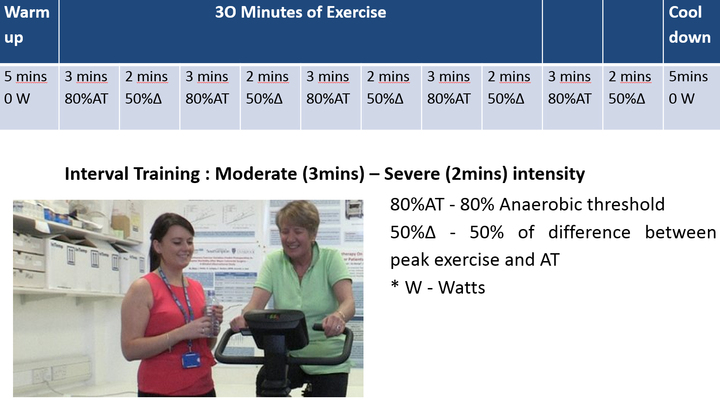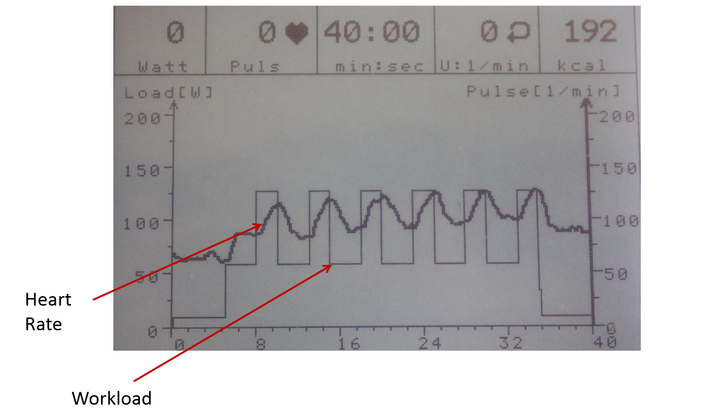Interval Exercise Training Programme
Structured Responsive Exercise Training Programme (SRETP)
This exercise programme was used in the following pilot study and subsequent studies by the fit 4 surgery group in Southampton, led by Professor Mike Grocott.
West MA, Loughney L, Lythgoe D, Barben CP, Sripadam R, Kemp GJ, et al.
Br J Anaesth. 2015;114(2):244-51.
High/severe-intensity interval training (consisting of repeated short periods of high-intensity work and recovery) has been shown to deliver similar increases in markers of aerobic capacity (anaerobic threshold (AT) and VO2peak) with approximately 10 times less total work (and therefore over a shorter time period) than continuous endurance training (Burgomaster J Physiol 586:151-1609, 2008).
This supervised structured responsive exercise training programme (SRETP) has been successfully performed in hospital in the context of clinical trials. The programme is performed using a computer controlled, electromagnetically braked, cycle ergometer (Ergoline 200, Germany). In studies it has increased anaerobic threshold and VO2peak on average by physiologically and clinically significant amounts (1.5-3 ml/kg/min) over periods of 6 weeks to 9 weeks of training in cancer patients during or after neoadjuvant chemotherapy or chemoradiotherapy.
Patients are screened prior to each session to ensure that it is safe to perform exercise. Each training session is stored on a chip and pin card to deliver and record each training session. In the first week of training, patients perform the interval exercise protocol repeatedly for 20 minutes. After the first week, the length of each training session is increased to 30 minutes. Each exercise session starts with 5 minutes of unloaded cycling for a warm up. This is followed by the exercise session that consists of 4 (for 20 minute session) or 5 (for 30 minute session) repeats of:
- 2 minutes high/severe-intensity cycling immediately followed by
- 3 minutes of moderate intensity cycling
Moderate intensity exercise is at a power output (Watts) equivalent to 80% of AT and high-intensity is at a power output that is half-way between AT and VO2Peak (termed 50% Delta). The power output is calculated as follows (to account for the kinetics of VO2):
Information required for calculating patient work rates (power output)
- Work rate in watts at the anaerobic threshold: WattsAT
- Work rate in watts at the VO2peak: WattsVO2peak
- Ramp increment in Watts
Work rate calculations:
- Watts adjustment for kinetics of VO2:
2/3 X ramp increment = R
- Moderate intensity work rate: 80% of AT:
( (WattsAT) - R) x 0.8
- 50% of Delta (difference between VO2peak and AT)
0.5 * ( (WattsVO2peak) - (WattsAT) ) = D
- Severe intensity work rate: is 50% of Delta work rate:
( (WattsAT) - R) + D

5 minutes of unloaded cycling is performed at the end of all training sessions for a cool down. Blood pressure is monitored every 3 minutes throughout exercise and heart rate is recorded continuously from the R-R interval (Polar FT7, Warwick, UK). A standard CPET test is performed to monitor the progression of training-induced improvements in physical fitness every three weeks. The absolute power output for subsequent training sessions is adjusted according to the outcome of CPET test.

Exercise sessions can be terminated by the patient at any time, and are terminated by the supervisor of the test if any of the criteria to stop the test are met, based on the ATS CPET safety guidelines.
Measured and derived variables recorded during exercise training:
Blood pressure Heart Rate
Heart Rate Variability Power output (Watts)

